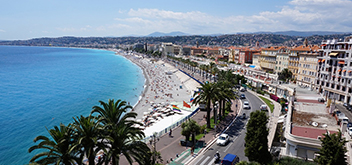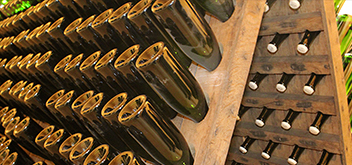No products
Wine Classification in Provence
Provence has eight main wine regions with AOC designations. TheCôtes de Provence is the largest followed by coteaux-d'aix-en-provence. Other significant wine regions include les-baux-de-provence, coteaux-varois-en-provence, coteaux-de-pierrevert, bandol, cassis, bellet and palette. The côtes-du-luberon AOC in the nearby the appellation is however officially part of the Rhône wine region and its typicity more closely approaches that of its neighbor on its northern border, côtes-de-ventoux AOC, also a Rhône wine. The region has several vin de pays designations, with bouches-du-rhône, near Aix-en-Provence, being one of the most common designations seen abroad.
Côtes-de-provence AOC
The côtes-de-provence AOC is a large wine region that covers 85 communes in the eastern region of Provence. The AOC extend from the alpine hills near Draguignan to the coast of Saint-Tropez. The region accounts for nearly 75% of all the wine production in Provence with rosé accounting for around 80% of the production. While the number is rising, about 15% of wine production is red wine with the remaining 5% white.
The main grape varieties are carignan, cinsault, grenache, mourvèdre and tibouren with an increase in the use of cabernet sauvignon andsyrah. Poducers are only allowed 40% carignanand 60% of the other grapes to improve quality. They also need at least 20% of the rosé must be blended from wine produced by the saignéemethod of maceration.
Coteaux-d'aix-en-provence
The coteaux-d'aix-en-provence AOC is the second largest Provençal wine appellation, the area comprises the city of Aix-en-Provence and 50 surrounding communes. almost 60% of the production is red wine, followed by 35% rosé and 5% white wine. The major grape varieties include grenache, cinsault and mourvèdre, andcabernet sauvignon from Bordeaux was introduced to the region in the 1960s. The main white wine grapes of the coteaux-d'aix-en-provence include bourboulenc, clairette,grenache blanc, chardonnay, sauvignon blancand sémillon.
Les-baux-de-provence
Within the coteaux-d'aix-en-provence is the smaller les-baux-de-provence AOC. The climate of the region is very hot and vineyards are centered around the hilltop village of the Les Baux-de-Provence. Red grape varieties account for around 80%. leading grape varieties aregrenache, mourvèdre and syrah. The AOC rule limits the amount of carignan, cinsault andcounoise. The use of cabernet sauvignon is growing in prevalence but it limited to composing no more than 20% of the blend. The rosés of Les Baux-de-Provence are composed of a minimum 60% of cinsault, grenache and syrah.
Les-baux-de-provence was the first AOC to require all vineyards to be farmed biodynamically. The rule was adopted as producers had already converted to organic viticulture, eliminating the use of chemicals that could easily dispersed from the vines by the strong Mistral wind.
Bandol
Bandol AOC, located near the coast east of Marseille, is one of the internationally recognized wines of the Provence regions. the AOC is produced by 8 communes with silicon & limestone soils. Those soils and the warm climate are ideally suited for main mourvèdre grape, late to ripen. For both the red and rosé wines,mourvèdre must account for at least 50% of the blend, though most producers will use significantly more, with grenache and cinsaultusually completing the composition. Syrah andcarignan are restricted in bandol to a maximum of 15%. Nearly 70% of the production is red wine with rosé and a small amount of white wine making up the remainder.
Red bandol wine is characterized by its dark color with rich flavors of black fruit, vanilla, cinnamon and leather and usually requires at least 10 years of aging before it fully develops, although some is produced to be drinkable in three years.
The white wines of bandol are composed primarily of clairette blanche, bourboulenc andugni blanc. Previously sauvignon blanc was used and is not prohibited by the AOC rules. The rosésof bandol are characterized by spicy and earthy flavors with some having strawberry notes.
Bandol is the only French wine that is dominated by the mourvèdre grape, which expresses differently depending on the soil and climate. The soils in the northwest region are composed of small pebbles and make more delicate and lighter wines. On the red clay, the wine produced is very tannic and must be tempered with cinsault and grenache. The relative infertility of the soil throughout the region helps to keep yields low with the bandolregion having some of the lowest yields in France.
Cassis
The cassis AOC, located along the coast between Marseille and Bandol, is unique in the Provençal wine region, due to white wine comprising over 75% of its production. The soil of the Cassis AOC is primarily limestone, which is particularly suited to the cultivation of clairette,marsanne, ugni blanc and sauvignon blanc, the major varieties of the area.
The dry white wines are characterized by their full bodies, low acidity and herbal aromas that pair well with the local seafood cuisine such as bouillabaisse. Local consumption has outpaced supply and has limited the amount of cassis wine that can be exported. Local laws are being developed in the region to protect vineyards from being overrun with commercial and residential development from the city of Marseille.


















